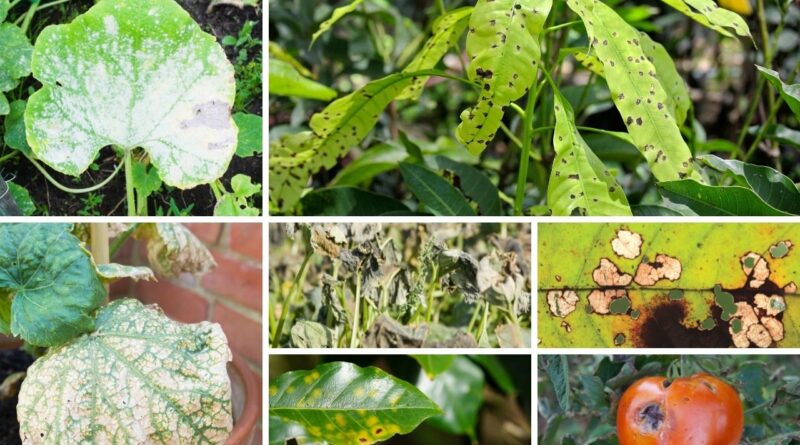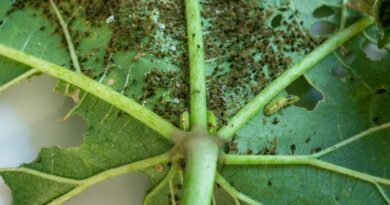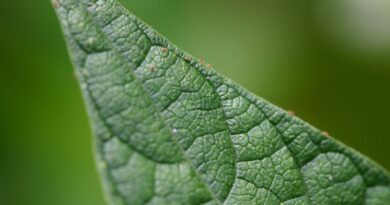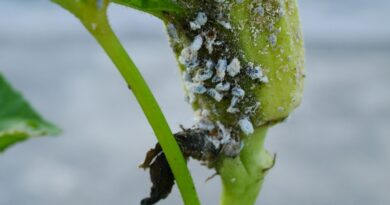10 Common Diseases in Urban Gardens
Powdery mildew- powdery mildew is a fungal disease that affects many plants. It usually appears as a white powdery layer on leaves, buds, flowers and fruits. Powdery mildew is most severe in crowded and shady locations with high humidity. Mildew can spread from one plant to another through gardening tools and equipment.
Downy mildew- downy mildew is also a fungal disease which appears as yellow to white patches on the upper surface of leaves. On the underside, these areas are covered with white to greyish cotton-like fungi. This disease occurs in cool and moist conditions. The disease can be spread by insects, wind, rain or garden tools.
Black sooty mould- sooty mould is usually a black powdery coating that develops on the leaves and stems of plants. Sometimes the black layer may be hard and stick tightly to the leaf. These fungi grow on honeydew, a sticky sugary substance produced by sap-sucking pests as they feed. Although the mould does not attack the plant directly, it affects the plants by covering the leaves and thus reducing photosynthesis.
Early blight- the first signs of early blight appear as small, circular or irregular dark brown to black spots with concentric rings that form a ‘bulls’ eye’ pattern on the lower leaves. As the disease progresses it spreads outward on the leaf surface causing it to turn yellow, wither and die. This disease is common in tomato and potato plants. This fungal disease can remain in the soil and can be spread by splashing rain, irrigation, insects and garden tools. Wet and humid conditions accompanied by high temperatures promote its rapid spread.
symptoms of early blight can occur on the foliage, fruit and stem at any stage of development.
Late Blight- just like early blight, late blight is also a fungal disease. However, each disease is caused by a different type of fungus. Late blight is also very common on tomatoes and potatoes. The first symptoms are irregularly shaped, water-soaked lesions often with a lighter ring around them. These lesions are typically found on the younger leaves in the top portion of the plant. During high humidity, white cottony growth may be visible on both sides of the leaves. Spots are visible on both sides of the leaves. As the disease matures lesions enlarge causing leaves to brown, shrivel and die.
Rust-leaf rust is a fungal disease that attacks garden plants in wet and humid conditions. As the name suggests, leaf rust looks similar to the kind of rust we get on metals. The first signs of rust are white or reddish to orange blister-like swellings on the underside of leaves and stems. Orange or yellow spots or streaks appear on the undersides of the leaves. The symptoms appear primarily on the surfaces of lower leaves. This disease leads to leaf distortion and defoliation.
Anthracnose– This fungal disease affects many plants including vegetables, fruits and trees. It first appears as small, irregular yellow or brown spots. Infected plants develop dark, sunken lesions on stems, leaves or fruit as the disease progresses. The centres of these lesions often become covered with pink masses of spores, especially during moist, warm weather.
Leaf spot- leaf spot can either be caused by fungi or bacteria. Both types of leaf spots are similar in appearance and effect. The infected plants have brown or black spots on the foliage sometimes with a yellow ring. The spots are usually uniform in size but they enlarge and run together as the disease progresses. Leaf spot diseases usually first appear on the lower and inner branches where humidity is higher and leaves are shaded. Both types of leaf spots are most active in moist and warm locations.
Wilt- wilt refers to several diseases which affect the water-conducting vessels of the plant. The fungi enter the plant from the soil through the roots and as the infection spreads up into the stems and leaves it restricts water flow causing the leaves to wilt and turn yellow. The disease symptoms are first noticed on the lower leaves, which eventually die and fall. Diseased plants may die soon after infection.
Mosaic virus- there are many types of viruses which affect plants but the most common viral disease in plants is the mosaic virus. There are different strains of mosaic viruses. These viruses affect a wide variety of horticultural and vegetable crops. Infected plant leaves have intermingled patches of light green or yellowish colours. The leaves are spotted with yellow, white and light or dark green spots which appear elevated giving the leaves a blister-like appearance. The plants are often stunted and they grow poorly. Plants may have other deformities and their leaves may be wrinkled or wavy.




